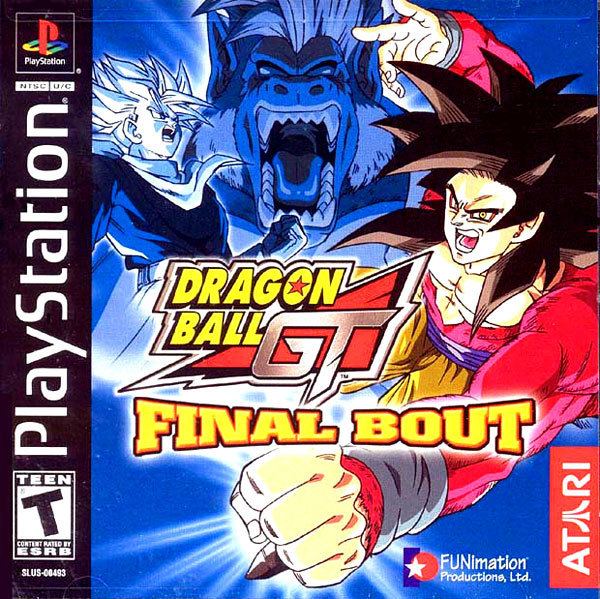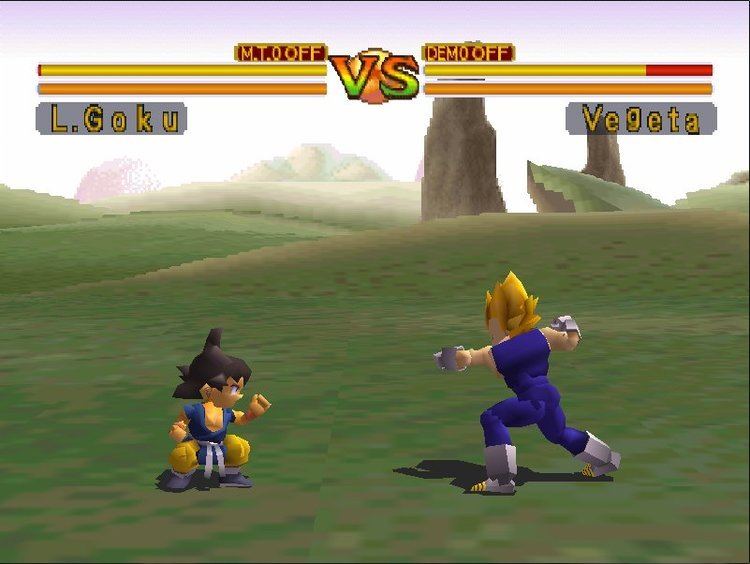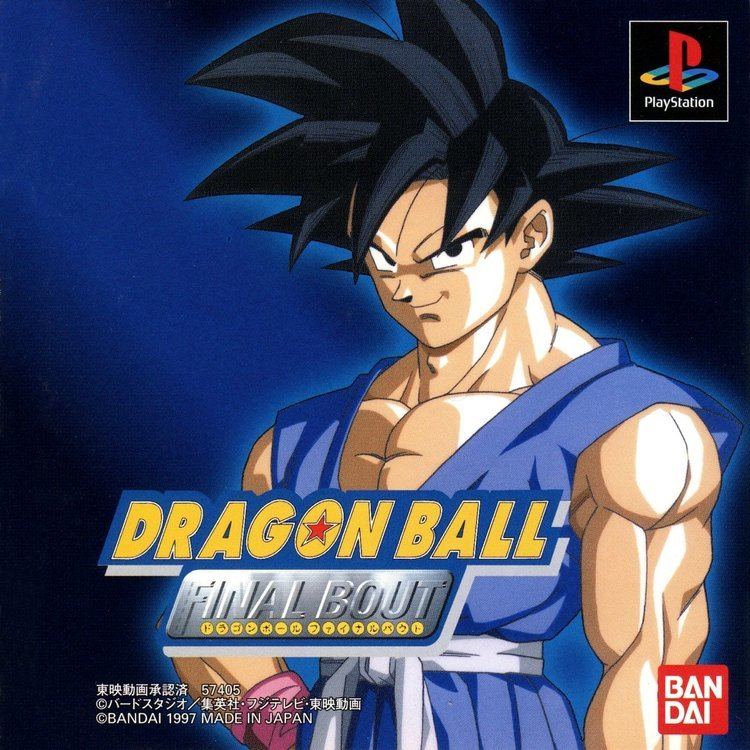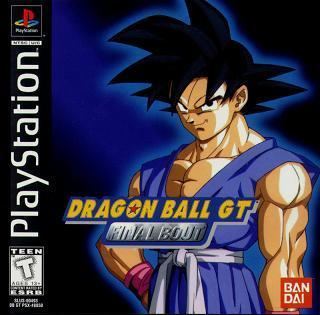9.1 /10 3 Votes
4.8/5 CoolROM | 4.4/5 Emuparadise 3/10 IGN Initial release date 1 February 1997 Adapted from Dragon Ball | |||||||||||||||||||||||||||||||||
 | ||||||||||||||||||||||||||||||||||
Designer(s) Jun HayashibaraKei Matsurikita Release date(s) JP: August 25, 1997 (1997-08-25)EU: November 6, 1997 (1997-11-06)NA: November 12, 1997 (1997-11-12)JP: July 20, 2000 (2000-07-20) (The Best)EU: October 4, 2002 (2002-10-04) (reprint)NA: August 24, 2004 (2004-08-24) (reprint) Mode(s) Single playerMultiplayer Similar Bandai games, Fighting games | ||||||||||||||||||||||||||||||||||
Dragon ball gt final bout intro hd
Dragon Ball GT: Final Bout, known in Japan and Europe as Dragon Ball: Final Bout (ドラゴンボール ファイナルバウト, Doragon Bōru Fainaru Bauto), is a fighting game for the PlayStation, based on the anime series Dragon Ball GT. It was developed and released by Bandai in Japan, parts of Europe, and North America in 1997. The game was reissued in Europe in 2002 and in North America in 2004. The game shares the distinction of being the first Dragon Ball game to be rendered in full 3D, and the last Dragon Ball game produced for the PlayStation. There would not be another Dragon Ball game for consoles until the release of Dragon Ball Z: Budokai in 2002.
Contents
- Dragon ball gt final bout intro hd
- Dragon ball gt final bout super goku s story
- Gameplay
- Battle Mode
- Tournament Mode
- Build Up Mode
- Playable characters
- Naming conventions
- Music
- Ports
- Localization
- Reception
- References

Dragon ball gt final bout super goku s story
Gameplay

The game is similar to other fighters but features 3D environments and characters from the Z and GT series of the Dragon Ball franchise. Unique in the game were the special ki attacks called a Special Knockout Trick. These were the spectacular versions of the character's ki attacks the player performed at a distance. When these attacks are performed, the camera would cut and pan to the attacking character who would power up and the player would fire. During the attacking character's power up, the opposing character would be giving the opportunity to either retaliate or block upon the moment the word counter would flash on the lower right hand corner of the screen. If the player chose to retaliate, they too would power up and fire a ki attack causing a power crossfire which the camera would go around both characters à la bullet time. Which player is pressing their button the fastest determines who receives the brunt of the blast. Another feature which was carried over from Legends, was a technique called Meteor Smash. With a key combo, players could ignite a chain of mêlée attacks.
Battle Mode

The standard mode, subdivided in "Vs Man", where a player can face another player, and "Vs Com", where the player fights a series of random CPU-controlled opponents and a final boss.
Tournament Mode

Subdivided in "The Tournament", in which up to 8 characters (either human o computer controlled) fight in a single-round elimination tournament, and "Build up the Tournament", where the characters are carried over from Build Up Mode, loaded from the memory card.
Build Up Mode
Carried over from Ultimate Battle 22, this feature gives the player the chance to train a character of their choosing and save them via a memory card. Unlike Ultimate Battle 22, this version of the mode allows to build the characters' strength to triple digit levels, and comes with an experience chart in the character's profile. Like Ultimate Battle 22, players have the opportunity to battle their friends with their character in the option called Build Up Battle.
Playable characters
The game's roster features a unique match-up from the Dragon Ball Z and GT series, primarily starting with the principal cast from the GT series: Goku, Trunks, and Pan. Regarding the latter, this was also the first game to feature her, while other characters Vegeta, Gohan, Piccolo, Cell, Frieza, and Buu came straight from the Z series. The only unplayble character is Baby Vegeta in his Oozaru form, serving as the game's final boss. The unlockable characters consist of the adult Super Saiyan form of Goku in his GT outfit, the Super Saiyan forms of GT kid Goku and Trunks, Z series Super Saiyan Goku, Super Saiyan Future Trunks, Vegeto and the Super Saiyan 4 form of Goku.
Naming conventions
The original Japanese release of the game was unique for its naming conventions for all the characters. All the adult incarnations of Goku are referred by his full name "Son Goku" (孫悟空) while his child incarnation is referred simply as "Goku" (悟空), and his Z series incarnation is presented in all capital rōmaji "SON GOKOU". GT Trunks is referred by his katakana "トランクス", while Future Trunks is presented in all capital English text "TRUNKS". Nearly all Super Saiyan characters are referred with the prefix Super (超), and Super Saiyan 4 Goku is referred as "Super 4 Son Goku" (超4孫悟空). This also applies to the super form of Oozaru Baby Vegeta who is referred as "Super Baby" (スーパーベビー). Both Vegeta and Vegito are simply referred as Vegeta and Vegetto and not Super Vegeta and Super Vegito despite they are both in Super Saiyan form. Finally, Kid Buu is referred as simply "Buu" (ブウ).
Music
The composition was done once again by Kenji Yamamoto. Out of all the pieces used in game, only five were new material, and the rest were remixed arrangements of previously used music from both 16- and 32-bit eras. The game also featured four brand new songs, the opening theme "Biggest Fight", the closing themes "Kimi o Wasurenai" and "Thank You", and Goku's Super Saiyan 4 theme "Hero of Heroes". All of these songs were performed by Hironobu Kageyama with Kuko providing backup vocals. On September 16, 1997, nine of the compositions and the four songs were released by Zain Records exclusive in Japan as Dragon Ball Final Bout: Original Soundtrack (ドラゴンボール ファイナルバウト オリジナルサウンドトラック, Doragon Bōru Fainaru Bauto Orijinaru Saundotorakku). The Future Trunks theme arrangement "Hikari no Willpower" was featured as a hidden bonus track.
Ports
The game was first released in Japan in 1997 under its original title Dragon Ball: Final Bout. It fared well enough in sales to be reissued under the PlayStation the Best for Family series a year later. In parts of Europe (France, Belgium, Spain and Portugal), the game was also released under the name Dragon Ball: Final Bout in 1997.
In North America, the game was released as Dragon Ball GT: Final Bout, and it was the first time a Dragon Ball video game was released in North America with the Dragon Ball license intact. Due to Dragon Ball's obscure popularity at the time, Bandai America only produced 10,000 copies of the game, thus making it a rare gem for collectors of both video games and Dragon Ball-related merchandise, with online retailers Amazon and eBay featuring prices for the game from $100 to $250 (however, it can now be bought online for cheaper prices).
In 2002, the game saw a release in the UK, along with other European countries that previously didn't officially receive the game. Finally under little fanfare, Atari reissued the game in 2004 with brand new artwork supplied by Toei Animation. This release coincided with Funimation's dub of Dragon Ball GT.
Localization
When the game was released throughout North America, several changes were made for localization. Dialog by the Japanese voice actors was replaced, but not by the then current voice cast at Ocean Group. Instead, Bandai America decided to use an uncredited cast of U.S. voice talent. However, the battle voices still consist of the Japanese voice cast, causing the character voices to clash. The game's opening theme, "Biggest Fight", was replaced with an untitled instrumental rock track in the opening FMV. The cast credits at the end of the game, also set to "Biggest Fight", were removed completely. The two closing songs "Kimi o Wasurenai" and "Thank You!" remain instrumental even when the game is beaten on normal and difficult settings. However, Super Saiyan 4 Goku's theme, "Hero of Heroes", was left unchanged. At the title screen, the game's sound test is available, whereas in the original Japanese it was a secret that players could only access by holding down certain buttons at once. The Buildup data transfer option was removed due to the fact Ultimate Battle 22 had not been released at that time. When the game was reissued in 2004, the game's data was not altered in any way from its 1997 North American release by Bandai.
The European 1997 version, like with most European Dragon Ball Z games from the 16-bit and 32-bit era, was released mostly unaltered from the Japanese version, featuring the original Japanese voice acting and with the game's opening theme "Biggest Fight" left intact. The game text was only translated to French and other languages besides English because of the lack of official release in any English-speaking country. When the game was re-issued in Europe in 2002 (which included a release for the first time in English-speaking countries like the UK), the game was kept the same as the previous European version except for the texts being re-translated to English.
Reception
Akin to many Dragon Ball-licensed games at the time, the critical response to Final Bout was generally negative. Frequent criticisms included sluggish controls and an overcharge of playable Goku incarnations.
